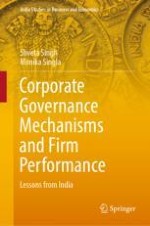2022 | OriginalPaper | Chapter
6. Constraints Diluting the Effectiveness of Board Independence
Authors : Shveta Singh, Monika Singla
Published in: Corporate Governance Mechanisms and Firm Performance
Publisher: Springer Nature Singapore
Activate our intelligent search to find suitable subject content or patents.
Select sections of text to find matching patents with Artificial Intelligence. powered by
Select sections of text to find additional relevant content using AI-assisted search. powered by
